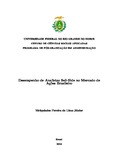Desempenho de analistas sell-side no mercado de ações brasileiro

Visualizar/
Data
2014-12-12Autor
Lima, Melquiades Pereira
1646302
http://lattes.cnpq.br/9184398019066167
Metadado
Mostrar registro completoResumo
The purpose of this study was to analyze the behavior of Sell-Side analysts and analysts
propose a classification, considering the performance of the price forecasts and recommendations (sell-hold-buy) in the Brazilian stock market. For this, the first step was to
analyze the consensus of analysts to understand the importance of this collective intervention in the market; the second was to analyze the analysts individually to understand how
improve their analysis in time. Third was to understand how are the main methods of
ranking used in markets. Finally, propose a form of classification that reflects the previous
aspects discussed. To investigate the hypotheses proposed in the study were used linear
models for panel to capture elements in time. The data of price forecasts and analyst
recommendations individually and consensus, in the period 2005-2013 were obtained from
Bloomberg○ R . The main results were: (i) superior performance of consensus recommendations, compared with the individual analyzes; (ii) associating the number of analysts
issuing recommendations with improved accuracy allows supposing that this number may
be associated with increased consensus strength and hence accuracy; (iii) the anchoring
effect of the analysts consensus revisions makes his predictions are biased, overvaluating
the assets; (iv) analysts need to have greater caution in times of economic turbulence,
noting also foreign markets such as the USA. For these may result changes in bias between
optimism and pessimism; (v) effects due to changes in bias, as increased pessimism can
cause excessive increase in purchase recommendations number. In this case, analysts can
should be more cautious in analysis, mainly for consistency between recommendation and
the expected price; (vi) the experience of the analyst with the asset economic sector and
the asset contributes to the improvement of forecasts, however, the overall experience
showed opposite evidence; (vii) the optimism associated with the overall experience, over
time, shows a similar behavior to an excess of confidence, which could cause reduction
of accuracy; (viii) the conflicting effect of general experience between the accuracy and
the observed return shows evidence that, over time, the analyst has effects similar to the
endowment bias on assets, which would result in a conflict analysis of recommendations
and forecasts ; (ix) despite the focus on fewer sectors contribute to the quality of accuracy,
the same does not occur with the focus on assets. So it is possible that analysts may have
economies of scale when cover more assets within the same industry; and finally, (x) was
possible to develop a proposal for classification analysts to consider both returns and the
consistency of these predictions, called Analysis coefficient. This ranking resulted better
results, considering the return / standard deviation.



